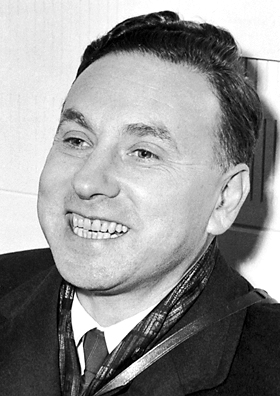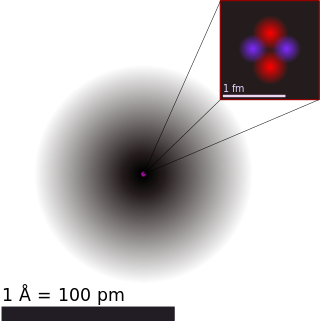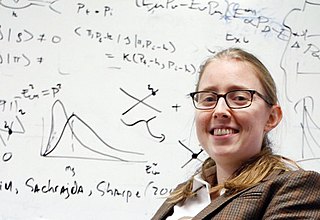Related Research Articles

Clermont-Ferrand is a city and commune of France, in the Auvergne-Rhône-Alpes region, with a population of 147,284 (2020). Its metropolitan area had 504,157 inhabitants at the 2018 census. It is the prefecture (capital) of the Puy-de-Dôme département. Olivier Bianchi is its current mayor.

Robert Hofstadter was an American physicist. He was the joint winner of the 1961 Nobel Prize in Physics "for his pioneering studies of electron scattering in atomic nuclei and for his consequent discoveries concerning the structure of nucleons".

The femtometre, symbol fm, is a unit of length in the International System of Units (SI) equal to 10−15 metres, which means a quadrillionth of one metre. This distance is sometimes called a fermi and was so named in honour of Italian naturalized to American physicist Enrico Fermi, as it is a typical length-scale of nuclear physics.

Thomas Jefferson National Accelerator Facility (TJNAF), commonly called Jefferson Lab or JLab, is a US Department of Energy National Laboratory located in Newport News, Virginia.

GlueX is a particle physics experiment located at the Thomas Jefferson National Accelerator Facility (JLab) accelerator in Newport News, Virginia. Its primary purpose is to better understand the nature of confinement in quantum chromodynamics (QCD) by identifying a spectrum of hybrid and exotic mesons generated by the excitation of the gluonic field binding the quarks. Such mesonic states are predicted to exist outside of the well-established quark model, but none have been definitively identified by previous experiments. A broad high-statistics survey of known light mesons up to and including the is also underway.
The A.I. Alikhanyan National Science Laboratory is a research institute located in Yerevan, Armenia. It was founded in 1943 as a branch of the Yerevan State University by brothers Abram Alikhanov and Artem Alikhanian. It was often referred to by the acronym YerPhI. In 2011 it was renamed to its current name A.I. Alikhanyan National Science Laboratory.
Nucleon spin structure describes the partonic structure of nucleon intrinsic angular momentum (spin). The key question is how the nucleon's spin, whose magnitude is 1/2ħ, is carried by its constituent partons. It was originally expected before the 1980s that quarks carry all of the nucleon spin, but later experiments contradict this expectation. In the late 1980s, the European Muon Collaboration (EMC) conducted experiments that suggested the spin carried by quarks is not sufficient to account for the total spin of the nucleons. This finding astonished particle physicists at that time, and the problem of where the missing spin lies is sometimes referred to as the proton spin crisis.
CEBAF Large Acceptance Spectrometer (CLAS) is a nuclear and particle physics detector located in the experimental Hall B at Jefferson Laboratory in Newport News, Virginia, United States. It is used to study the properties of the nuclear matter by the collaboration of over 200 physicists from many countries all around the world.
The EMC effect is the surprising observation that the cross section for deep inelastic scattering from an atomic nucleus is different from that of the same number of free protons and neutrons. From this observation, it can be inferred that the quark momentum distributions in nucleons bound inside nuclei are different from those of free nucleons. This effect was first observed in 1983 at CERN by the European Muon Collaboration, hence the name "EMC effect". It was unexpected, since the average binding energy of protons and neutrons inside nuclei is insignificant when compared to the energy transferred in deep inelastic scattering reactions that probe quark distributions. While over 1000 scientific papers have been written on the topic and numerous hypotheses have been proposed, no definitive explanation for the cause of the effect has been confirmed. Determining the origin of the EMC effect is one of the major unsolved problems in the field of nuclear physics.
James P. Vary is an American theoretical physicist and professor at the Iowa State University, specializing in nuclear theory with an emphasis on "ab initio" solutions of quantum many-particle systems and light-front quantum field theory.

Christine Angela Aidala is an American high-energy nuclear physicist, Alfred P. Sloan Research Fellow and Associate Professor of Physics at the University of Michigan. She studies nucleon structure and parton dynamics in quantum chromodynamics.
Elena Amanda Long is assistant professor of physics at the University of New Hampshire and is an activist for LGBT people in science. The journal Nature called her a "diversity trailblazer" in their Nature's 10: Ten people who mattered this year in 2016. Long's research on the internal structure of nucleons earned her a 2015 Jefferson Science Associates (JSA) Promising Young Scientist award. Long has made significant contributions to improve the inclusion of under-represented researchers and students by founding the LGBT+ Physics organisation and serving as a member of the American Physical Society (APS) Committee of LGBT Issues.
Elizabeth J. (Betsy) Beise is a Professor of Physics and Associate Provost at the University of Maryland, College Park. She works on quantum chromodynamics, nucleon structure and fundamental symmetries.
Kawtar Hafidi is a Moroccan-American experimental nuclear physicist and the Associate Laboratory Director for Physical Sciences and Engineering at Argonne National Laboratory. She researches nucleon and nuclear structure using major accelerator facilities, e.g., Jefferson Lab, DESY, and Fermilab. She is also an advocate for diversity and almost became a professional soccer player when she was 16.

Cynthia E. Keppel is the Hall A and C Leader at the Thomas Jefferson National Accelerator Facility and a Fellow of the American Physical Society. Her research focuses on the quark-gluon structure of the nucleon, while also considering applications of nuclear physics in medicine. She was a founding member of the Hampton University Proton Therapy Institute.
Xiangdong Ji is a Chinese theoretical nuclear and elementary particle physicist. He is a Distinguished University Professor at the University of Maryland, College Park.

Phiala Elisabeth Shanahan is an Australian theoretical physicist who lives and works in the United States. She is known for her work on the structure and interactions of hadrons and nuclei and her innovative use of machine learning techniques in lattice quantum field theory calculations.

Volker D. Burkert is a German physicist, academic and researcher. He is a Principal Staff Scientist at the Thomas Jefferson National Accelerator Facility at Jefferson Lab (JLab) in Newport News, Virginia (USA). He has made major contributions to the design of the CEBAF Large Acceptance Spectrometer (CLAS) that made it suitable for high luminosity operation in experiments studying spin-polarized electron scattering.
Calvin Rudolph Howell is an American physicist and professor at Duke University in Durham, North Carolina.
Franz Lucretius Gross is an American theoretical physicist.
References
- 1 2 3 "Biography" (PDF). IPAC. Retrieved 5 October 2018.
- ↑ "Hall B Scientific Staff Bios". JLab. Retrieved 5 October 2018.
- 1 2 "A Career Built on the Strongest Force in the Universe | Jefferson Lab". www.jlab.org. 2021-12-09. Retrieved 2024-09-06.
- ↑ "Latifa Elouadrhiri". GWU Department of Physics. GWU. Retrieved 4 October 2018.
- ↑ Dietrich, Tamara. "Local women scientists explain the 'trouble' with Tim Hunt". Chicago Tribune. Retrieved 5 October 2018.
- ↑ "U.S. Embassy Morocco". Twitter. Twitter. Retrieved 5 October 2018.
- ↑ "US Embassy Rabat". Facebook. Facebook. Retrieved 5 October 2018.